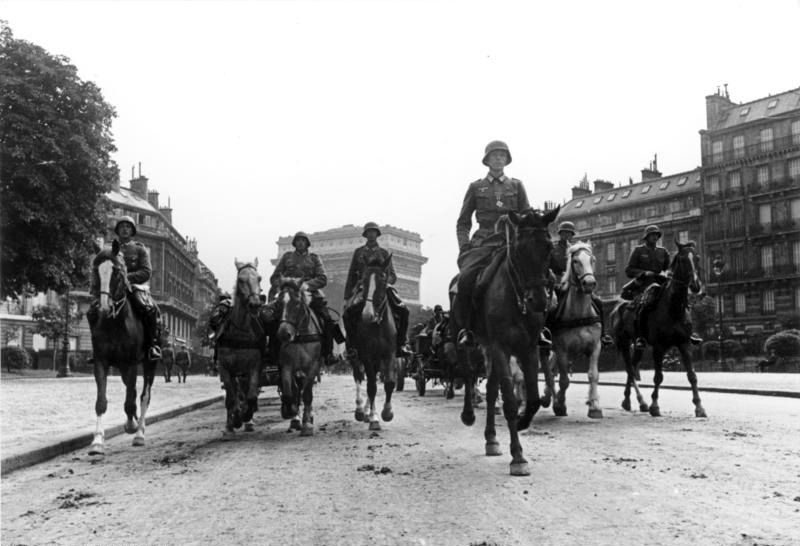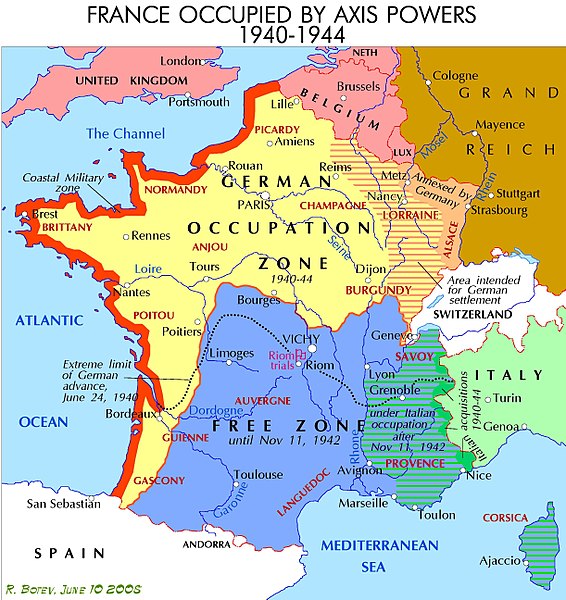
Public Domain
On 21 June 1940 near Compiegne and in the same railway car Germany surrendered in 1918, France officially surrendered to Nazi Germany. For Adolf Hitler and his fellow Nazi leaders, this erased the shame of 1918 and the imposition of the Versailles Treaty. Hitler sat in the same chair that Marshal Ferdinand Foch had sat in 1918 to accept the German surrender in World War I.
France at the outset of the war was considered to have the best professional army in continental Europe. Aside from trained soldiers, they had tanks and heavy artillery. And, of course, the famous Maginot Line. This was a series of fortifications near the German border meant to deter an invasion force. The hills and woods of the Ardennes were considered impenetrable in the north but there was a caveat as General Philippe Petain noted. You had to destroy the invasion force before it exited that area. France and Germany had officially been at war since 3 Sep 1939 when France, allied with England, offered support to the Polish government.
French forces briefly entered the Saar on 7 September but withdrew after meeting a very thin line of German defense on the undermanned Siegfried line. With most of its forces concentrated in Poland at the time, Germany did not have the capacity to stand up to France’s 98 divisions and tanks that were being c0mmitted. However French hesitation and wanting to avoid total war had them withdraw forces starting on 17 September and done a month later. It began a time called the Phony War where both Germany and France were armed and ready, but nothing was happening. Hitler had hoped he could make peace with England and France but that was not to be.
On 10 May 1940, Germany attacked France. German armored units made a push through the Ardennes, and then through the Somme valley to surround the allied units in Belgium. British, Belgian and French forces were pushed to the sea. British forces were evacuated at Dunkirk, which is an exciting tale of its own. During the six-week campaign Germany conquered France, Belgium, Luxembourg, and The Netherlands. German troops marched unopposed into Paris on 14 June. By 18 June with the collapse of both the French government (which had fled) and the military, negotiations began between French and German military officers.

Photo: Heinz Fremde (1907-1987)
German Federal Archives:Bundesarchiv, Bild 101I-126-0350-26A / Fremke, Heinz / CC-BY-SA 3.0
At the meeting on 21 June, Hitler read the preamble and like Marshal Foch left to leave Field Marshal Wilhelm Keitel, commander-in-chief of the Wehrmacht to handle the details. There were several objectives that the Germans wanted and got. They wanted French North Africa and the French Navy out of the war. Also, they wanted to deny the British use of French territories since they could not possibly defend them. Occupied France was 3/5ths of the country which included the key ports on the French Channel and Atlantic and to the Spanish border. The Free Zone was administered by a newly formed French government in Vichy with Marshal Petain as its president.
Vichy France, as it became known, was authoritarian and reversed the policies of previous administrations. The media became tightly controlled, anti-Semitism was propagated, and labor unions put under strict controls. Vichy France kept French territories and the navy under French rather than German control. With the German army elsewhere, unoccupied France was generally free from military control. However due to its neutrality forbidden to assist nations at war with Germany. Despite it being unoccupied, Vichy had to conform to German policies including identifying foreign nationals, deporting stateless persons, and of course assisting Germans in locating and ultimately deporting French Jews to murdered in the death camps.

Rostislav Botev
The treaty was formally concluded on 22 June 1940 and went into effect on 25 June 1940. A separate treaty between France and Italy was signed as well. Italy initially only wanted a small portion of France (about 832 square miles with the largest town being Menton). In November 1942, after Germany seized a large portion of Vichy, Italy got control over Toulon and the eastern part of Provence up to the Rhone river. Corsica and Nice were also to become Italian occupied but that did not occur. During the period of Italian occupation, Jews were relatively safe as Italian authorities declined German requests to turn over Jews to them. Once Italy deposed Mussolini and later signed an armistice with the Allies in 1943, Germans quickly moved in and rounded up all Jews they could locate. Over 3,000 would be deported.
Aftermath
Three days after the signing of the treaty, the armistice site was destroyed on Hitler’s orders. The railway car was sent to Germany as a trophy of war. A monument depicting the French victory over the Germans was destroyed. The only thing left standing was the large statue of Marshal Foch. Hitler ordered it left there to stare out over a wasteland. The railway carriage would later be destroyed by the SS in 1945. An exact copy of the original railway car was made. French manufacturer Wagons-Lits donated a car from the same series to the Armistice Museum (in Compiegne) in 1950. Identical and was part of Foch’s private train during the 1918 signing. Remains of the original car were dug up using German POW’s. The railway car is parked beside the display of those remains.
The fall of France to Germany in 1940 demonstrated that the leaders in many European capitols had misjudged Hitler. Hitler understood early on neither the British or French would go to war over Czechoslovakia nor Austria as they wanted to avoid a general war. In this way, he understood them better than they did knowing that while many would oppose what he would do, in the end they would cave in and agree to terms. In both Britain and France, the desire to avoid total war at any cost was quite strong. The policy of appeasement flowed from this. That is why both the British and French, despite having signed peace treaties with Czechoslovakia, would betray and then force them to give into German demands. And why France, when it had the upper hand to go into Germany to stop it when it was invading Poland, made a quick march in and then left Germany. With most of the German army to the east, they could have really put Hitler into a bind.
Hitler, for his part, did misjudge their reactions to invading Poland. He assumed they would denounce it but do nothing more. Things had changed in Britain with Chamberlain’s policy of appeasement now judged a failure resulting in Churchill being brought into the government. Churchill had warned for years about Hitler. France had been a supporter of appeasement as well but wanted more British support before fully committing to war. There was also an arrogance which assumed that the British and French were better militarily than the Germans. To some degree, that is true since Germany was defeated in World War I and prior to that had been checked by the European powers. Both Britain and France, which had excellent intelligence gathering abilities, were not streamlined so a lot of important information about Germany’s intentions didn’t get up to the top right away. And France thought Germany would be deterred by the Maginot Line, which turned out not to be the case. They would use the Belgium invasion as a decoy to swing into France.
Some argue that Germany was simply lucky, but I disagree. Hitler played both the British and French knowing they would give in to avoid total war. He knew that the political left in France would never allow them to strike Germany without Britain committing to it as well. Britain was also unprepared for war having not enough planes, ships, or infantry to take them on directly. They were trying to get second-hand equipment from the United States, which so far was staying out of the conflict. And Hitler knew the British would try operations to keep Germany from controlling sea access and control resources (which was true by the way). And by the end of 1940, Hitler had achieved what the Kaiser failed to do in World War. He had conquered nearly all of Europe: Belgium, France, The Netherlands, Denmark, Norway and swallowed up the small principalities in-between. Only Portugal, Spain, Switzerland, and Sweden were untouched but neutral. And fascist Italy was on their side as well, unlike the last war. He also had made peace with Stalin, so he did not have to worry about the Soviet Union.
The lesson, aside from the military ones, is that when a leader of another nation says that without reservation he will invade and take your country, you should take it seriously. And prepare for it. Because if you don’t, you might very well live just long enough to see his troops marching down your capitol’s streets as they celebrate their victory.
Sources
Byron, H. (2024, January 20). The French Riviera under Italian Rule during WW2 — HANNAH BYRON. HANNAH BYRON. https://www.hannahbyron.com/blog/the-french-riviera-under-italian-rule-during-ww2
Hart, B. L. (2024, June 17). Battle of France | History, summary, maps, & Combatants. Encyclopedia Britannica. https://www.britannica.com/event/Battle-of-France-World-War-II/The-fall-of-France-June-5-25-1940
Hughes, T. A., & Royde-Smith, J. G. (2024, June 17). World War II | Facts, summary, history, dates, combatants, & Causes. Encyclopedia Britannica. https://www.britannica.com/event/World-War-II/Italys-entry-into-the-war-and-the-French-Armistice
Sullivan, M. (2024, June 13). France signals intention to surrender to the Nazis. HISTORY. https://www.history.com/this-day-in-history/france-to-surrender
Videos
Smithsonian Channel. (2017, June 15). The moment France surrendered to German soldiers [Video]. YouTube. https://www.youtube.com/watch?v=eLrZi5udyIc
British Pathé. (2014, April 13). French Surrender to Hitler (1940) [Video]. YouTube. https://www.youtube.com/watch?v=ADUcjRc5p3k
Suggested Reading
Bloch, M. (1999). Strange defeat: A Statement Of Evidence Written In 1940. W. W. Norton & Company.
Churchill, W. (1948). Their finest hour. Houghton Mifflin Harcourt.
Keegan, J. (2005). The Second World War. Penguin Books.
Lord, W. (2017). The Miracle of Dunkirk: The True Story of Operation Dynamo. Open Road Media.
Shirer, W. L. (2022). The collapse of the Third Republic: An Inquiry Into the Fall of France in 1940. Rosetta Books
Historical Movies or Television
Wouk, H. (2018, December). Winds of War [Special Collector’s Edition]. Paramount. This excellent six-part miniseries is based on the Herman Wouk novel of the same name. And he wrote the script for this, so it hues close to the book (but does compress or eliminate some characters or situations). Through the Henry family, we get to see the scope of the looming war approaching and their involvement in it. The acting is superb, though the actress Ali MacGraw is miscast as Natalie Jastrow. Aside from that, this is a riveting depiction of the events leading up to World War II. It is one of the best miniseries ever made, and it shows with the high production quality and attention to detail.
Titanic News Channel is a participant in the Amazon Services LLC Associates Program, an affiliate advertising program designed to provide a means for sites to earn advertising fees by advertising and linking to Amazon.com.





